
History abounds in the Galilee. Consider a brief stop at Hamat Teverya National Park, an historical gem in the Galilee. The site is adjacent to the Sea of the Galilee. As we walked from the parking lot, Jacob Firsel, our private guide, pointed out the low water level. The docks were far above the sea.
Since the time of antiquity, this area has been known for its hot springs and the healing qualities of its water. The water averages 60 degrees Celsius (140 degrees Fahrenheit). No wonder early inhabitants of this area called the city “Hamat,” the Hebrew word for “hot.” In the Roman period, a new city called Teverya was founded. Thereafter, the area became known as Hamat Teverya.
While the area is only partially excavated, the average visitor will learn a substantial amount from a visit.
Three Ancient Synagogues
The site boasts the remains of three ancient synagogues. The first was built around 230 CE. Only a small piece of mosaic remains. The second synagogue was active during the third and fourth centuries. An amazing mosaic floor can be viewed. To date, it is the oldest mosaic synagogue floor found in Israel. This synagogue is sometimes referred to as the Severan Synagogue. The synagogue was destroyed by an earthquake in the fifth century. A third synagogue was erected on top of the ruins. It was a more elaborate structure. It ceased to function in the eighth century.
Sites Inside Hamat Teverya National Park
After paying our admittance fee, we saw a few steam chimneys. Hot vapor could be seen. However, our cameras could not fully capture this natural wonder. Underneath the park, are 17 saline hot springs that release their steam through the chimneys.
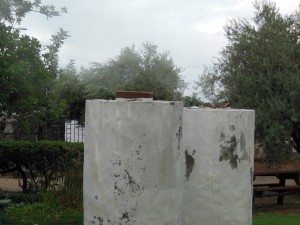
Walking along the pathway, we observed a stream of water. We bent down to touch the “hot” murky colored water.
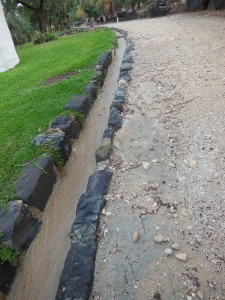
Although little remains of this ancient city, we were reminded of former times when we read the blue sign that stated, “Here passed the street leading to the city gate. (6th-8th century CE)”

Olive trees and pomegranate trees hugged the walkway.
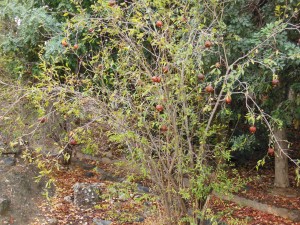
We looked down upon a covered area.
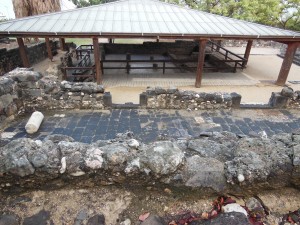
Very little remains of the southern gate to the city. The southern wall was part of the wall erected around Tiberius by Caesar Justinius in the 6th century.
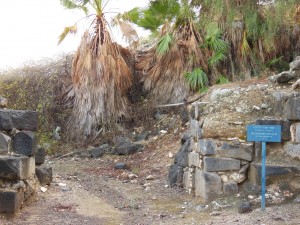
Archaeologists have created a drawing that illustrates the structure of the synagogue.
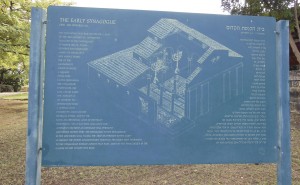
Inside this space, we gazed upon the stunning mosaic floor. The mosaic had three defined areas. On one end were two lions that bordered nine inscriptions written in Greek. This is a list of the donors.
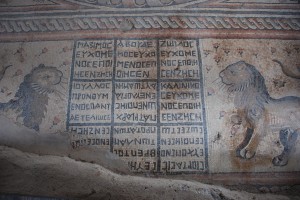
In the middle, there was a Zodiac wheel that bordered the image of Helios, the sun god.
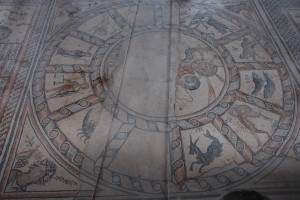
The last section, included the Holy Ark, two 7 branched candelabra, a shofar (ram’s horn), and lulavs (palm branches).
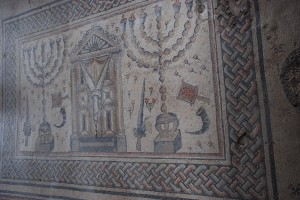
One of the Greek inscriptions included a reference to Severus, the founder of the synagogue. Thus, some refer to this synagogue as the Severan Synagogue. In Aramaic, there was a blessing to anyone who has or will give charity in this sacred place.
In previous trips to Israel, we visited ancient synagogues that also included depictions of the Zodiac. It remains unclear why these Jews chose to include symbols from another culture.
The courtyard of the third synagogue is seen in the next picture.
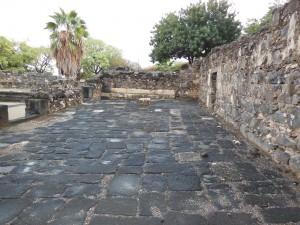
Fragment of another mosaic could be viewed from the path.
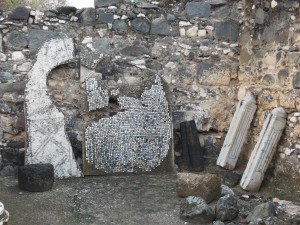
At this location, one can also view the remains of a Roman Bathhouse, the Hamam Suleiman (Turkish bath and museum), the nearby tomb of Rabbi Meir, and enjoy the peaceful atmosphere of the Sea of the Galilee.
Reflecting on the Visit
Our leisurely stroll through the Hamat Teverya National Park provided additional pieces of information about life in the first few centuries of the Common Era. The visit also raised questions regarding assimilation, the effects of natural disasters on established communities, and the ability to coexist with one’s neighbors. If you’re interested in these topics and this time period, consider a visit to Hamat Teverya National Park – a historical gem in the Galilee.
Sandra Bornstein is the author of MAY THIS BE THE BEST YEAR OF YOUR LIFE. It is available on Amazon.
If you enjoyed reading my memoir, consider posting a review on Amazon, Goodreads, LibraryThing and/or AskDavid.com.
Leave a Reply
You must be logged in to post a comment.